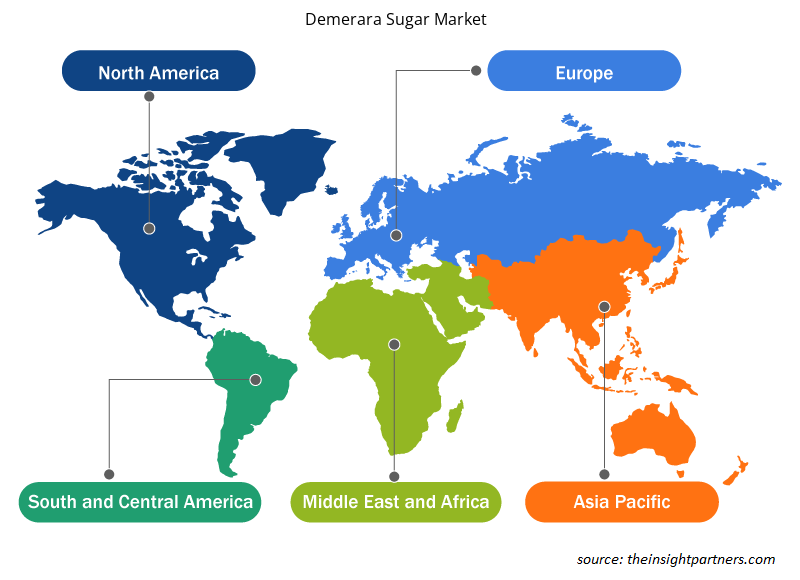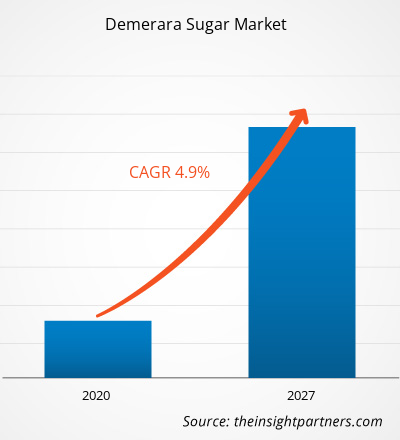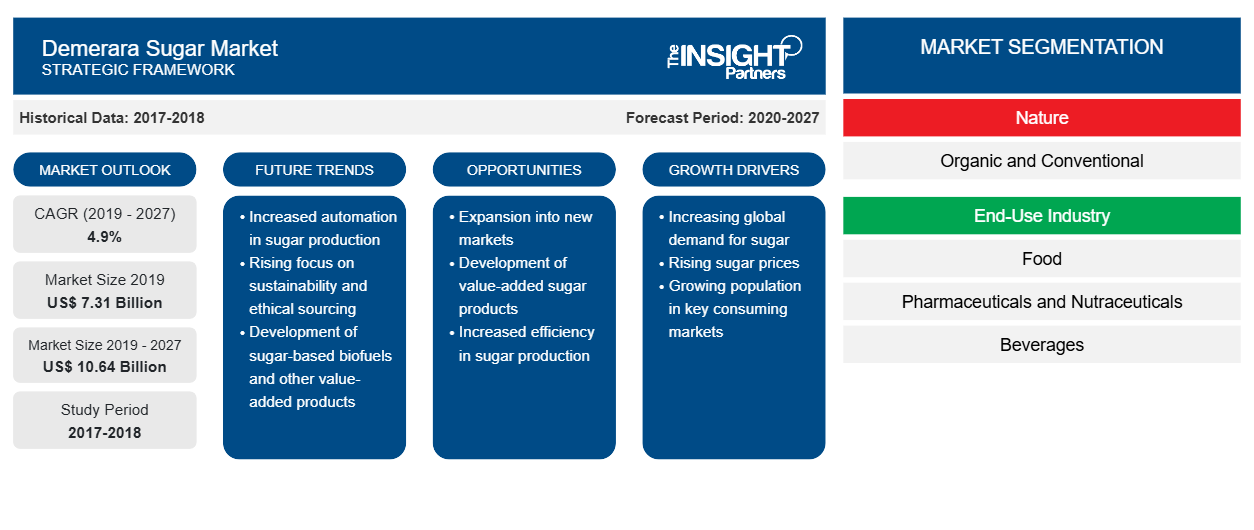El mercado de azúcar demerara se valoró en US$ 7.305,88 millones en 2019 y se proyecta que alcance los US$ 10.635,27 millones en 2027; se espera que crezca a una CAGR del 4,9% entre 2020 y 2027.
El azúcar Demerara se obtiene de la caña de azúcar y está formado por granos grandes que aportan una textura dulce y crujiente en repostería y otras aplicaciones. Se utiliza principalmente como gragea para decorar tartas y magdalenas. También se puede añadir al café y al té. El azúcar Demerara contiene de forma natural una pequeña cantidad de melaza, lo que le da un color marrón claro y un sabor a caramelo. El azúcar Demerara contiene un contenido de sacarosa significativamente menor (88-93%) que el azúcar blanco (96-98%). El azúcar Demerara contiene minerales vitales como manganeso, magnesio, zinc, cromo y cobalto. El azúcar Demerara es originario de Guyana, Sudamérica, y la mayor parte del azúcar Demerara disponible en la actualidad proviene de Mauricio, en África. Además, las crecientes aplicaciones del azúcar Demerara en el sector alimentario ofrecen oportunidades lucrativas para los principales actores del mercado.
Se espera que el mercado mundial de azúcar demerara en Asia-Pacífico crezca a la tasa de crecimiento anual compuesta (CAGR) más alta del 5,2 % durante el período 2020-2027. Se espera que la creciente demanda de azúcar demerara de diversas industrias de uso final, como alimentos, productos farmacéuticos y nutracéuticos, y bebidas, impulse el crecimiento del mercado durante el período de pronóstico.
El brote de COVID-19 se informó por primera vez en Wuhan (China) durante diciembre de 2019. A partir de enero de 2021, EE. UU., Rusia, India, China, Italia, Francia y Alemania se encuentran entre los países más afectados en términos de casos positivos de COVID-19 y muertes reportadas. Según las cifras de la OMS actualizadas en enero de 2021, se han notificado ~85.929.428 casos confirmados y ~1.876.100 muertes a nivel mundial. El brote está afectando negativamente a las economías y las industrias debido a los confinamientos, las prohibiciones de viaje y los cierres de negocios impuestos por los gobiernos. La alimentación y las bebidas es una de las principales industrias del mundo que sufre graves interrupciones en forma de interrupciones de la cadena de suministro, cancelaciones de eventos tecnológicos y cierres de oficinas. Aunque China es el centro de fabricación mundial y el mayor proveedor de materias primas para varias industrias del mundo, también es uno de los países más afectados por la pandemia de COVID-19. El cierre de varias plantas y fábricas en China está alterando las cadenas de suministro globales, así como las actividades de fabricación y las ventas de diversas materias primas utilizadas en la industria alimentaria y los productos finales. El cierre de fábricas, los obstáculos en las cadenas de suministro y la desaceleración de la economía mundial están frenando el crecimiento general del mercado del azúcar demerara.
Personalice este informe según sus necesidades
Obtendrá personalización en cualquier informe, sin cargo, incluidas partes de este informe o análisis a nivel de país, paquete de datos de Excel, así como también grandes ofertas y descuentos para empresas emergentes y universidades.
- Obtenga las principales tendencias clave del mercado de este informe.Esta muestra GRATUITA incluirá análisis de datos, desde tendencias del mercado hasta estimaciones y pronósticos.
Perspectivas del mercado
Las crecientes aplicaciones del azúcar Demerara en la panadería impulsan el crecimiento del mercado
El azúcar demerara es un tipo de azúcar de caña en bruto que se procesa mínimamente. Está disponible en forma de granos grandes de color ámbar y se utiliza principalmente como ingrediente de guarnición. En la industria de la panificación, el azúcar demerara se utiliza en gran medida como cobertura para productos horneados como muffins, bollos, galletas, pasteles y también para migajas. El demerara tiene un sutil sabor a melaza que lo hace más delicioso que el azúcar blanco normal. Mantiene los productos horneados suaves y húmedos. La mezcla de azúcar y agua ayuda al azúcar a retener la humedad para que los productos como galletas, muffins, brownies y glaseados no se sequen demasiado fácilmente. Produce ternura, profundiza el color y el sabor y agrega crocancia. Debido a esto, se usa ampliamente en aplicaciones de panadería. Principalmente contiene la cantidad adecuada de calcio y magnesio, y también contiene vitaminas B3, B5 y B6. También se sabe que el azúcar demerara es útil para retener las vitaminas y minerales presentes de forma innata en la caña de azúcar. Además, el azúcar Demerara contiene sustancialmente menos sacarosa (88-93%) que el azúcar blanco (96-98%). La creciente conciencia sobre los beneficios para la salud del azúcar Demerara está impulsando la demanda de su incorporación en diversas recetas.
Perspectivas de la naturaleza
Según la naturaleza, el mercado del azúcar demerara se bifurca en orgánico y convencional. El segmento convencional representó una mayor participación de mercado en 2019; mientras que, se espera que el mercado del azúcar demerara orgánico crezca a una CAGR más alta durante el período de pronóstico. La forma convencional de técnica de cultivo es ampliamente adoptada entre los agricultores para obtener un mayor rendimiento y disponibilidad de producto a bajo costo. La técnica favorece a los productores y cultivadores ya que los rendimientos son altos en comparación con el costo. Además, la falta de conocimiento entre los agricultores sobre los beneficios para la salud asociados con la agricultura orgánica ha promovido el crecimiento del segmento. Por ejemplo, en 2017, casi el 63% de los agricultores adoptaron la agricultura convencional para producir azúcar demerara y el 37% de ellos optaron por la agricultura orgánica en Turquía. Sin embargo, existen varias desventajas relacionadas con este método. El azúcar demerara producido por el método convencional puede contener menos nutrientes. La agricultura convencional es uno de los métodos agrícolas más practicados que implica el uso de fertilizantes, pesticidas y otros compuestos químicos. Además, también implica riesgos para la salud y el medio ambiente, ya que implica la liberación de contaminantes al medio ambiente.
Perspectivas de la industria de uso final
Según la industria de uso final, el mercado del azúcar demerara está segmentado en alimentos, productos farmacéuticos y nutracéuticos, bebidas y otros. El segmento de alimentos representó la mayor participación del mercado en 2019, y se espera que el otro segmento registre la CAGR más alta durante 2020-2027. El azúcar demerara tiene una textura crujiente y una forma de cristal dorado grande y brillante. Los cristales grandes significan que conserva su forma cuando se cocina. Es perfecto para espolvorear y también se puede usar para hornear, especialmente en artículos como bases de tarta de queso, crumbles, flapjacks y galletas que necesitan un toque crujiente adicional. El azúcar demerara es un azúcar de caña crudo sin refinar con grandes cristales de color toffee. Se utilizan principalmente para ofrecer la textura deseada en pasteles, en una cubierta de streusel para un pastel, en un crumble o como cobertura crujiente para galletas.
Información sobre el canal de distribución
Según el canal de distribución, el mercado del azúcar demerara se segmenta en tiendas de comestibles, supermercados o hipermercados, distribuidores y mayoristas, minoristas en línea y otros. El segmento de distribuidores y mayoristas representó la mayor participación del mercado en 2019, mientras que se espera que el segmento de minoristas en línea registre la CAGR más alta durante el período de pronóstico. La empresa designa a un distribuidor para vender el producto en su nombre. El minorista en línea es el mediador entre los productores/fabricantes y los minoristas. Venden y promocionan el producto en nombre de los fabricantes a las partes interesadas. Además, un mayorista opera como mediador entre el minorista y el distribuidor. Estas personas compran un producto en una cantidad sustancial del fabricante o distribuidor a un precio más barato y lo revenden a los minoristas a un precio más alto para obtener ganancias. Los distribuidores encuentran mayoristas que revenderán los productos. Un mayorista trabaja más de cerca con los minoristas para satisfacer sus necesidades comprando productos a granel con descuento. Un distribuidor participa activamente para promover los productos de una empresa, un mayorista no. Los productos adquiridos en las tiendas favoritas suelen implicar una distribución desde diversas fuentes. Llevar un producto al mercado requiere principalmente un canal de marketing eficaz para las empresas que fabrican bienes duraderos y otros productos. Una cadena de suministro suele contar con varios intermediarios entre un fabricante y un consumidor.
Las fusiones y adquisiciones, el lanzamiento de productos y la investigación y el desarrollo son estrategias que las empresas adoptan habitualmente para expandir su presencia en todo el mundo, lo que está teniendo un impacto positivo en el tamaño del mercado del azúcar demerara. Los actores que operan en el mercado, como Ragus Sugars Manufacturing Limited, Tate & Lyle y otros, han estado implementando estas estrategias para ampliar la base de clientes, ganar una participación de mercado significativa y mantener su marca a nivel mundial. Por ejemplo, en julio de 2017, Tate & Lyle lanzó su nueva gama de productos de azúcar moreno y dorado premium llamada Taste for Adventure. La gama de productos incluye una mezcla de cinco tipos de azúcar moreno y dorado orgánico premium, como Dark Soft Brown, Organic Dark Soft Brown, Golden Caster, Organic Golden Caster y Demerara.
Perspectivas regionales del mercado del azúcar de Demerara
Los analistas de Insight Partners explicaron en detalle las tendencias y los factores regionales que influyen en el mercado del azúcar de Demerara durante el período de pronóstico. Esta sección también analiza los segmentos y la geografía del mercado del azúcar de Demerara en América del Norte, Europa, Asia Pacífico, Oriente Medio y África, y América del Sur y Central.

- Obtenga datos regionales específicos para el mercado de azúcar de Demerara
Alcance del informe sobre el mercado del azúcar de Demerara
| Atributo del informe | Detalles |
|---|---|
| Tamaño del mercado en 2019 | 7.310 millones de dólares estadounidenses |
| Tamaño del mercado en 2027 | US$ 10,64 mil millones |
| CAGR global (2019-2027) | 4,9% |
| Datos históricos | 2017-2018 |
| Período de pronóstico | 2020-2027 |
| Segmentos cubiertos | Por naturaleza
|
| Regiones y países cubiertos | América del norte
|
| Líderes del mercado y perfiles de empresas clave |
|
Densidad de actores del mercado de azúcar de Demerara: comprensión de su impacto en la dinámica empresarial
El mercado del azúcar de Demerara está creciendo rápidamente, impulsado por la creciente demanda de los usuarios finales debido a factores como la evolución de las preferencias de los consumidores, los avances tecnológicos y una mayor conciencia de los beneficios del producto. A medida que aumenta la demanda, las empresas amplían sus ofertas, innovan para satisfacer las necesidades de los consumidores y aprovechan las tendencias emergentes, lo que impulsa aún más el crecimiento del mercado.
La densidad de actores del mercado se refiere a la distribución de las empresas o firmas que operan dentro de un mercado o industria en particular. Indica cuántos competidores (actores del mercado) están presentes en un espacio de mercado determinado en relación con su tamaño o valor total de mercado.
Las principales empresas que operan en el mercado azucarero de Demerara son:
- Corporación Azucarera de Guyana Inc.
- Alimentos británicos asociados plc.
- Grupo Tereos
- Industrias LOC
- Nordzucker AG
Descargo de responsabilidad : Las empresas enumeradas anteriormente no están clasificadas en ningún orden particular.

- Obtenga una descripción general de los principales actores clave del mercado de azúcar de Demerara
Informe Destacado
- Tendencias progresivas de la industria en el mercado mundial del azúcar demerara que ayudan a los actores a desarrollar estrategias efectivas a largo plazo
- Estrategias de crecimiento empresarial adoptadas por los mercados desarrollados y en desarrollo
- Análisis cuantitativo del mercado desde 2017 hasta 2027
- Estimación de la demanda mundial de azúcar demerara en diversas industrias
- Análisis PEST para ilustrar la eficacia de los compradores y proveedores que operan en la industria para predecir el crecimiento del mercado
- Avances recientes para comprender el escenario competitivo del mercado y la demanda mundial de azúcar demerara
- Tendencias y perspectivas del mercado y factores que impulsan y restringen el crecimiento del mercado del azúcar demerara
- Comprensión de las estrategias que sustentan el interés comercial respecto al crecimiento del mercado, lo que facilita un proceso eficaz de toma de decisiones.
- Tamaño del mercado de azúcar de Demerara en varios nodos del mercado
- Descripción detallada y segmentación del mercado, así como dinámica de la industria.
- Tamaño del mercado mundial de azúcar demerara en varias regiones con oportunidades de crecimiento prometedoras en estas regiones
El mercado del azúcar de Demerara, por naturaleza
- Orgánico
- Convencional
Mercado de azúcar de Demerara, por industria de uso final
- Alimento
- Productos farmacéuticos y nutracéuticos
- Bebidas
- Otros
Mercado de azúcar de Demerara, por canal de distribución
- Tiendas de comestibles
- Supermercados o Hipermercados
- Distribuidores y Mayoristas
- Minoristas en línea
- Otros
Perfiles de empresas
- Corporación Azucarera de Guyana Inc.
- Alimentos británicos asociados plc.
- Grupo Tereos
- Industrias LOC
- Nordzucker AG
- Ragus Sugars Fabricación Limitada
- Compañía azucarera australiana ltda.
- Tate y Lyle
- Alteo limitada
- Azúcares y productos químicos Rajshree Ltd.
- Análisis histórico (2 años), año base, pronóstico (7 años) con CAGR
- Análisis PEST y FODA
- Tamaño del mercado, valor/volumen: global, regional y nacional
- Industria y panorama competitivo
- Conjunto de datos de Excel
Informes recientes
Informes relacionados
Testimonios
Razón para comprar
- Toma de decisiones informada
- Comprensión de la dinámica del mercado
- Análisis competitivo
- Información sobre clientes
- Pronósticos del mercado
- Mitigación de riesgos
- Planificación estratégica
- Justificación de la inversión
- Identificación de mercados emergentes
- Mejora de las estrategias de marketing
- Impulso de la eficiencia operativa
- Alineación con las tendencias regulatorias





















 Obtenga una muestra gratuita para - Mercado de azúcar de Demerara
Obtenga una muestra gratuita para - Mercado de azúcar de Demerara